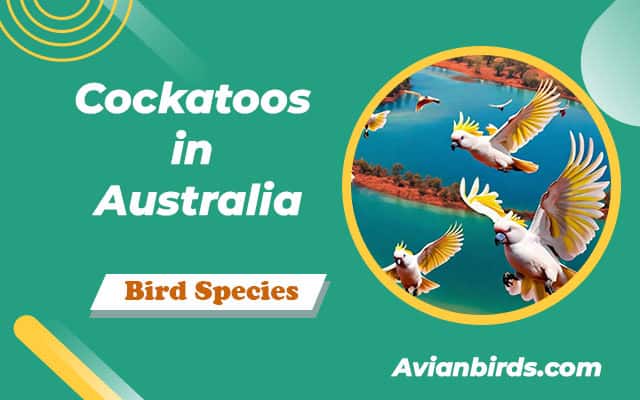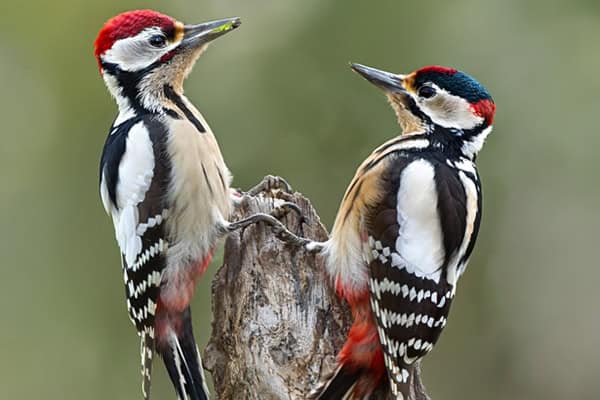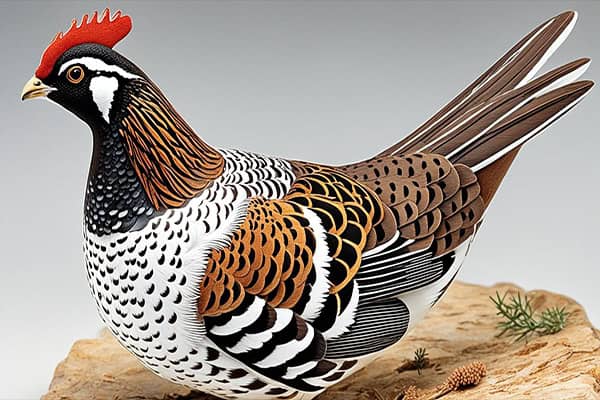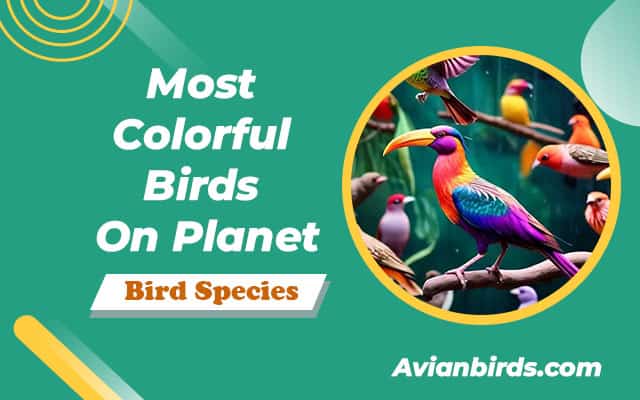17 Types Of Cockatoos in Australia (Cacatuidae family)
Cockatoos in Australia, from the Cacatuidae family, are quite the spectacle, with their vibrant feathers and lively antics. Some species have adapted well to captivity. But what exactly makes these birds stand out among the rest? The white parrot, often a description used synonymously with certain cockatoo species, showcases the diversity within the cacatuidae family.
Its ability to thrive both in the wild and in captivity is certainly a significant factor. We’ll get into the various species within the Genus Cacatua, Genus Callocephalon, often referred to in historical texts, archived from the original documents detailing Frederick II’s menagerie., Genus Calyptorhynchus, Genus Eolophus, Genus Lophochroa, and Genus Nymphicus to uncover their unique traits and habitats.
Moreover, from the charming Blue-Eyed Cockatoo to the majestic Sulphur-Crested Cockatoo, each species has its own story to tell. we’ll tell you how these birds adapt to different environments and communicate with each other. Additionally, we’ll discuss the purpose behind their eye-catching crests which makes them unique among other birds.
Here are the main points:
- Australasian Cockatoos, from the Cacatuidae family, are known for their vibrant plumage and distinctive crests.
- The Genus Cacatua includes species such as the Blue-Eyed Cockatoo, Red-Vented Cockatoo, and Sulphur-Crested Cockatoo.
- The Genus Callocephalon is home to the unique Gang-Gang Cockatoo.
- The Glossy Black Cockatoo and Red-Tailed Black Cockatoo belong to the Genus Calyptorhynchus.
- The Galah represents the Genus Eolophus, while the Major Mitchell’s Cockatoo, also known as the pink cockatoo, is admired for its striking colors. is the sole species in the Genus Lophochroa.
- The Cockatiel, from the Genus Nymphicus, is a popular and beloved pet bird.
1. Genus Cacatua
Let’s move the amazing world of cockatoos in the Genus Cacatua. Also, This group has many different types of colorful and beautiful birds. From the impressive Blue-Eyed Cockatoo to the lively Yellow-Crested Cockatoo, each kind of bird has its own special traits, where it lives, and how it acts.
1.1 Blue-Eyed Cockatoo (Cacatua ophthalmica)

Blue-Eyed Cockatoo, named after its beautiful blue eyes, is native to the remote rainforests of Indonesia. This beautiful bird is known for its striking crest and cool nature. With its captivating appearance and melodic calls and the Blue-Eyed Cockatoo is a favorite among bird enthusiasts.
1.2 Red-vented cockatoos in Australia (Cacatua haematuropygia)

The Red-Vented Cockatoo, with its vibrant red feathers and playful disposition, can be found in the forests of Southeast Asia. These social birds are known for their ability to mimic sounds and their energetic personalities. Observing their spirited antics is always a delight.
1.3 Salmon-Crested Cockatoo (Cacatua moluccensis)
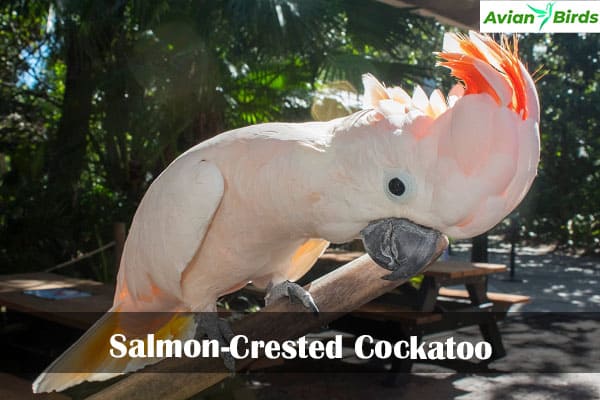
Salmon-crested cockatoos, also known as the Moluccan Cockatoo found in Australia, is a majestic bird native to the Moluccan Islands in Indonesia. With its elegant salmon-colored crest and gentle temperament, this cockatoo serves as a stunning example of nature’s artistic mastery.
1.4 Solomons Cockatoo (Cacatua ducorpsii)

Endemic to the Solomon Islands, the Solomons Cockatoo showcases a unique combination of black, white, and yellow feathers. These intelligent birds are known for their inquisitive nature and remarkable problem-solving abilities.
1.5 Sulphur-Crested Cockatoo (Cacatua galerita)

Sulphur-crested cockatoos are charismatic species found across Australia and New Guinea. Recognizable by its striking yellow crest, this cockatoo is highly sociable and often seen in flocks. Their loud calls and playful behaviors make them a joyful presence in their native habitats.
1.6 White Cockatoo (Cacatua alba)

The White Cockatoo is a beautiful bird with its pristine white plumage and elegant crest. Native to Indonesia and the Philippines, these cockatoos are highly intelligent and known for their ability to learn complex tasks. Their striking appearance and intelligence make them a popular choice among bird enthusiasts.
1.7 Yellow-Crested Cockatoo (Cacatua sulphurea)

Yellow-Crested Cockatoo, with its stunning yellow crest and expressive eyes, is native to the islands of Indonesia. Unfortunately, this species is endangered due to habitat loss and illegal wildlife trade. Efforts are underway to protect and conserve these magnificent birds.
1.8 Little Corella (Cacatua sanguinea)

Little Corella, also known as the Bare-Eyed Cockatoo, is a small but charismatic bird found in Australia. With its pinkish throat and bright blue eye ring, this cockatoo adds a splash of color to the Australian landscape. Their sociable nature and playful antics make them a beloved sight across the country.
1.9 Long-Billed Corella (Cacatua tenuirostris)

Long-Billed Corella is a striking cockatoo species native to Australia. Recognizable by its long, curved bill and elegant white plumage, these birds are often seen in large flocks. Their distinctive appearance and distinctive calls make them a unique addition to the avian world.
1.10 Tanimbar Corella (Cacatua goffiniana)
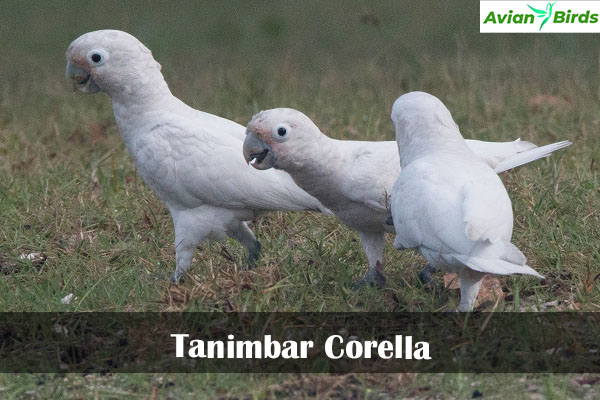
Tanimbar Corella, named after the Tanimbar Islands in Indonesia, is a charming cockatoo species with its soft gray feathers and a playful personality. These birds are known for their acrobatic abilities and their love for engaging with toys and puzzles.
1.11 Western Corella (Cacatua pastinator)

The Western Corella, native to Western Australia, is a visually striking bird with its bold red facial patches and elegant white plumage. They are often seen in large flocks, creating a mesmerizing spectacle in the sky. Their vocalizations and social behavior add to their allure.
As we explore these unique species within the Genus Cacatua, we will uncover their distinctive features, habitats, and behaviors, gaining a deeper appreciation for the enchanting world of cockatoos.
| Cockatoos Species in Australia | Distinctive Features | Habitat | Behavior in captivity can vary significantly from their wild counterparts due to the different environmental and social stimuli. |
|---|---|---|---|
| Blue-Eyed Cockatoo (Cacatua ophthalmica) | Blue eyes, striking crest | Indonesian rainforests | Gentle, melodic calls |
| Red-vented cockatoo (Cacatua haematuropygia) | Red feathers, playful | Southeast Asian forests | Mimics sounds, energetic |
| Salmon-Crested Cockatoo (Cacatua moluccensis) | Salmon-colored crest | Moluccan Islands, Indonesia | Gentle temperament |
| Solomons Cockatoo (Cacatua ducorpsii) | Black, white, and yellow feathers | Solomon Islands | Inquisitive, problem-solving |
| Sulphur-Crested Cockatoo (Cacatua galerita) | Yellow crest | Australia, New Guinea | Sociable, playful, these traits make cockatoos popular pets in captivity. |
| White Cockatoo (Cacatua alba) | White plumage, elegant crest, features that make the white parrot a standout, much like Major Mitchell’s Cockatoo, also known as the pink cockatoo for its vibrant hues. | Indonesia, Philippines | Intelligent, learns complex tasks, a quality that has endeared them to many who keep cockatoos in captivity. |
| Yellow-Crested Cockatoo (Cacatua sulphurea) | Yellow crest | Indonesian islands | Endangered, efforts for conservation |
| Little Corella (Cacatua sanguinea) | Pinkish throat, blue eye ring | Australia | Sociable, playful |
| Long-Billed Corella (Cacatua tenuirostris) | Long, curved bill, white plumage often seen in captivity among the cockatoos. | Australia | Seen in large flocks |
| Tanimbar Corella (Cacatua goffiniana) | Soft gray feathers | Tanimbar Islands, Indonesia | Acrobatic, loves puzzles |
| Western Corella (Cacatua pastinator) | Red facial patches, white plumage | Western Australia | Seen in large flocks, vocal |
2. Genus Callocephalon
If you’re captivated by unique and striking birds, the Gang-Gang Cockatoo, the only species in the Genus Callocephalon, will undoubtedly pique your interest. With its distinctive appearance, behavior, and habitat, this fascinating cockatoo offers a delightful experience for bird enthusiasts, even when observed in captivity.
2.1 Gang-Gang Cockatoo (Callocephalon fimbriatum)
The Gang-Gang Cockatoo is widely recognized for its stunning plumage that exhibits a striking contrast of colors. The males flaunt a sleek bluish-gray body with a vibrant red head and crest, while the females showcase an enchanting mix of light gray and pale pink tones.

Unlike some of its larger relatives, the Gang-Gang Cockatoo possesses a playful and inquisitive nature, making it a joy to observe. These social birds form tight-knit family groups and often communicate through a range of calls, including their iconic “creaky gate” vocalization.
When it comes to habitat, the Gang-Gang Cockatoo prefers the temperate forests and woodlands of Australia, particularly in the southeastern regions. They rely on the availability of native eucalyptus trees and their seeds as a primary food source, ensuring their survival in their natural environment.
“The Gang-Gang Cockatoo’s unique appearance and playful behavior are truly captivating, making it a cherished sighting for birdwatchers.” – E. L. Wilson
To provide a deeper understanding of the Gang-Gang Cockatoo’s characteristics, behavior, and conservation status, let’s explore the table below:
| Genus | Species | Appearance | Behavior | Habitat | Conservation Status |
|---|---|---|---|---|---|
| Callocephalon | Gang-Gang Cockatoo | Sleek bluish-gray body, red head and crest (males); light gray and pale pink plumage (females) | Playful, social, communicates through various calls | Temperate forests and woodlands in southeastern Australia | Least Concern |
As demonstrated by the table, the Gang-Gang Cockatoo stands out with its unique appearance, playful behavior, and preference for temperate forests. Although its conservation status is currently listed as Least Concern, ongoing efforts are crucial to protect their habitats and ensure their long-term survival.
3. Genus Calyptorhynchus
We will get into the two captivating species of black cockatoos: the Glossy Black Cockatoo and the Red-Tailed Black Cockatoo. Belonging to the Genus Calyptorhynchus, these magnificent birds offer a unique glimpse into the diverse world of Australian avian fauna.
3.1 Glossy Black Cockatoo (Calyptorhynchus lathami)

The Glossy Black Cockatoos (Calyptorhynchus lathami) are characterized by its stunning glossy black plumage and vibrant red tail feathers. This medium-sized cockatoo is native to eastern Australia and can be found in habitats ranging from coastal woodlands to forests. Its specialized diet consists primarily of seeds from various casuarina trees, making it highly dependent on the availability of these trees. Unfortunately, the Glossy Black Cockatoo is considered vulnerable due to habitat loss and fragmentation.
3.2 Red-Tailed Black Cockatoo (Calyptorhynchus banksii)
The Red-Tailed Black Cockatoo (Calyptorhynchus banksii) is another striking member of the Calyptorhynchus genus. With its bold, black feathers and a striking red panel on its tail, this cockatoo species is a symbol of Australia’s unique biodiversity. The Red-Tailed Black Cockatoos of Australia have a wide distribution, inhabiting varied ecosystems such as woodlands, savannas, and coastal regions. It primarily feeds on the seeds of various native trees, demonstrating an essential role in seed dispersal. However, habitat loss and ongoing threats have resulted in population declines for this species, leading to its classification as vulnerable.

These black cockatoo species not only contribute to the visual splendor of Australia’s avian populations but also play vital ecological roles as seed dispersers. Conservation efforts are essential to mitigate the threats they face and ensure their continued existence in the wild.
| Cockatoo Species | Scientific Name | Habitat | Conservation Status |
|---|---|---|---|
| Glossy Black Cockatoo | Calyptorhynchus lathami | Coastal woodlands, forests | Vulnerable |
| Red-Tailed Black Cockatoo | Calyptorhynchus banksii | Woodlands, savannas, coastal regions | Vulnerable |
4. Genus Eolophus
Let’s turn our attention to the Genus Eolophus, which is home to the fascinating Galah. Native to Australia, the Galah is a beloved species known for its striking appearance and engaging behavior.
4.1 Galah (Eolophus roseicapilla)
The Galah, scientifically known as Eolophus roseicapilla, is a medium-sized cockatoo with a unique combination of pink and gray feathers. Its rose-pink head and chest create a visually stunning contrast against its light gray body.

One of the Galah’s distinctive features is its crest. While not as pronounced as other cockatoo species, the Galah sports a small, elegant crest that adds to its charm.
“The Galah has a playful and social nature, often engaging in playful antics with other members of its flock,” explains ornithologist Jane Thompson. “Their acrobatic flight displays and vocalizations contribute to their lively and energetic personality.”
The Galah can be found in various habitats, including woodlands, grasslands, and even urban areas. They are highly adaptable birds, capable of thriving in a range of environments.
These intelligent birds are known for their resourcefulness when it comes to finding food. They have a diverse omnivorous diet that includes seeds, nuts, fruits, and even insects.
Conservation Status
Although Galahs are abundant and widely distributed throughout Australia, changes in land use and habitat destruction can impact their population. However, they are not currently classified as a threatened species and are protected under Australian law, although some cockatoo species are considered pests in regions like Tasmania.
| Galah | Description |
|---|---|
| Scientific Name | Eolophus roseicapilla |
| Size | Approximately 35-40 cm (14-16 in) |
| Weight | Around 270-350 grams (9.5-12.3 oz) |
| Coloration | Gray body with a rose-pink head and chest |
| Habitat | Woodlands, grasslands, and urban areas |
| Diet | Omnivorous diet consisting of seeds, nuts, fruits, and insects |
5. Genus Lophochroa
5.1 Major Mitchell’s Cockatoo (Lophochroa leadbeateri)
We will explore the captivating world of Major Mitchell’s Cockatoo, the sole representative species in the Genus Lophochroa. With its stunning appearance, playful behavior, and unique distribution, this cockatoo has become a favorite among bird enthusiasts and nature lovers.

Captivating Appearance
The Major Mitchell’s Cockatoos are known for their striking beauty and are also found in Australia. Its plumage features a combination of soft pinks, whites, and bold splashes of vibrant colors, creating a truly mesmerizing sight. Their majestic crests, crowned with hues of red, yellow, and orange, add an extra touch of elegance.
The Major Mitchell’s Cockatoo is truly a showstopper. Their radiant colors and intricate crests are a visual feast for the eyes.
These cockatoos are medium-sized birds, measuring around 40 to 50 centimeters in length. They have strong, curved beaks designed for cracking open nuts and seeds, their primary diet in the wild.
Playful Behavior
Much like their counterparts in the cockatoo family, Major Mitchell’s Cockatoos are known for their playful and sociable nature. They are highly intelligent birds, capable of learning tricks and mimicking human speech. Their natural curiosity keeps them engaged and enthusiastic, making them delightful companions.
Major Mitchell’s Cockatoos are not only beautiful but also incredibly entertaining. Their playful antics and ability to mimic make them a joy to observe.
These cockatoos are also exceptional dancers. With their elegant crest displays and synchronized movements, they can captivate anyone with their charming performances.
Distribution
The habitat of Major Mitchell’s Cockatoos spans across the arid and semi-arid regions of interior Australia. They can be found in open woodlands, savannahs, and scrublands. However, their population is patchy and localized due to the availability of suitable nesting sites and food resources.
Currently, the conservation status of Major Mitchell’s Cockatoos is classified as “near threatened” on the IUCN Red List. They face threats such as habitat loss, illegal trapping for the pet trade, and competition for nesting hollows from other bird species.
Major Mitchell’s Cockatoo
| Scientific Name | Genus | Size | Habitat | Conservation Status |
|---|---|---|---|---|
| Lophochroa leadbeateri | Lophochroa | 40-50 cm | Arid and semi-arid regions of interior Australia | Near Threatened |
As shown in the table above, Major Mitchell’s Cockatoo, scientifically known as Lophochroa leadbeateri, belongs to the Genus Lophochroa. They measure around 40 to 50 centimeters in size and primarily inhabit the arid and semi-arid regions of interior Australia. Due to various threats, including habitat loss and illegal trapping, their conservation status is listed as “near threatened”.
6. Genus Nymphicus
As we reach the final section of our exploration into the fascinating world of Australasian Cockatoos, we come across the beloved and popular Cockatiel, the sole representative species of the Genus Nymphicus. With their charming and playful nature, Cockatiels have captured the hearts of bird enthusiasts and pet owners alike.
6.1 Cockatiel (Nymphicus hollandicus)
Cockatiels, also known as Nymphicus hollandicus, are small parrots native to Australia. Their cheerful personalities and ability to mimic sounds make them delightful companions. These charismatic birds are famous for their distinguishable crest on the top of their heads, which adds to their unique appeal.

With their friendly and sociable nature, Cockatiels enjoy interacting with their human companions and are known for their intelligence and ability to learn tricks and vocalizations. Their docile temperament and relative ease of care make them ideal pets for both experienced bird owners and beginners.
Whether they are entertaining you with their affectionate behavior, vibrant plumage, or adorable crest, Cockatiels bring joy and companionship to countless households. They have become a beloved family pet, admired for their charm and adaptability.
Check our Previous Articles:
Frequently Asked Questions About Cockatoos in Australia
Q1. Are there cockatoos in Australia?
Yes, cockatoos are found in Australia.
Q2. What do Australians call cockatoos?
Australians commonly refer to cockatoos simply as “cockies.”
Q3. What Australian bird is like a cockatoo?
The bird most similar to a cockatoo in Australia is the galah.
4. What are 3 facts about cockatoos?
- Cockatoos are known for their vibrant plumage and distinctive crests.
- They are highly social birds and often form large flocks.
- Cockatoos are intelligent and can be trained to perform various tricks and behaviors.

